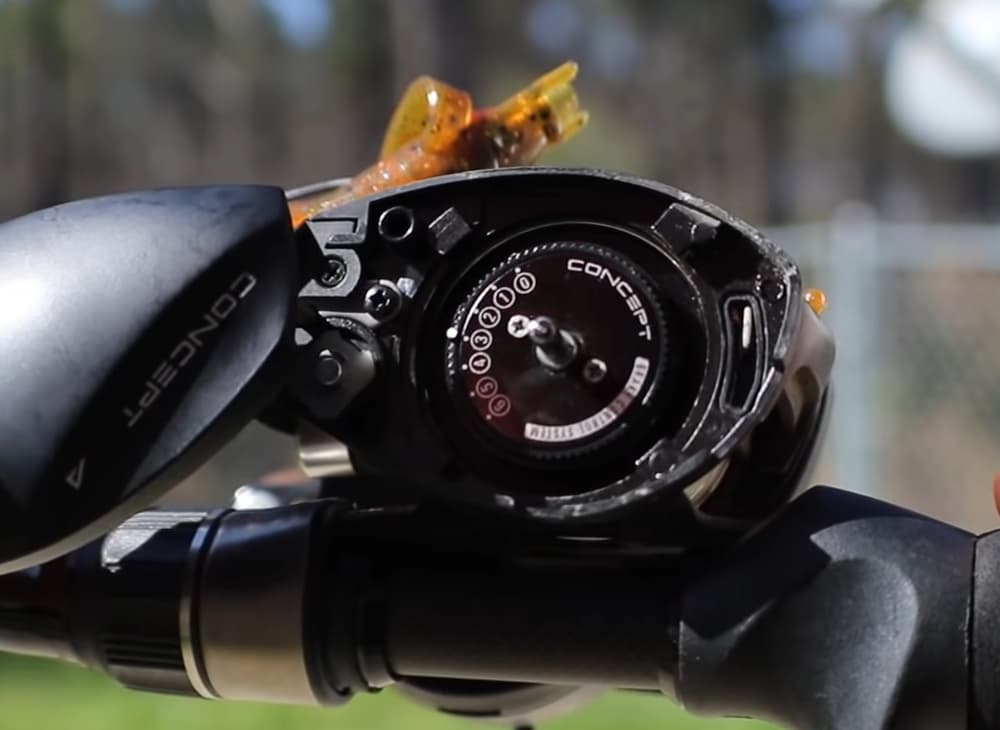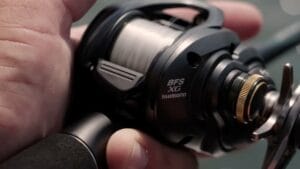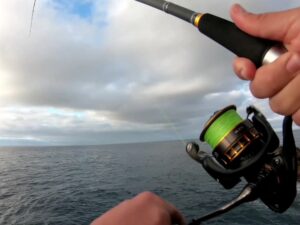Braking systems on baitcasting reels are one of the most important parts of the reel. If you’ve never fished with a casting reel before, you may not have any idea what I’m talking about. The purpose of these braking systems is to prevent backlash. If you’ve fished with a baitcaster before, you know how annoying backlash and birdnesting can be. There are a number of ways you can avoid it, and they all come down to the braking system.
Why Do Baitcasting Reels Have Braking Systems?
The purpose of the braking system on a fishing reel is to avoid backlash, which in turn saves you time and money. Backlash, also referred to as birdsnest, is the term used to describe the tangled mess of line that comes spilling out of your reel once it’s been subjected to some sudden force, usually caused by something hitting the line or your lure like when your lure hits the waters after a long cast.
So when you hit something and there’s a sudden loss of tension, the spinning spool will continue turning until there’s nothing left to pull, at which point the reel will stop. But that’s not the case with a low profile baitcasting reel. An unadjusted braking system will cause all of the line to come out at once, which will result in a big knot of tangled mess. A lot of times, you’ll need to get a friend to help you get rid of it.
How Do They Work?
First of all, there are four types of braking systems: centrifugal, magnetic, electronic, and the most traditional “manual” method. Each of these have their own individual mechanisms on how they work.
However, they all have the same similar purpose, which is to help slow down the fast moving spool during your cast. When you make a cast, the line is pulled out of the reel and sent forward. However, the spool is still turning around at a fast pace. If the speed of the spool is faster than that of the cast, then you will experience backlash.
Most of the times, it will happen at the end of your cast, when you stop the lure and the lure’s weight still continues down the line.
But what happens is that the reel will continue to spin and the line on the other side of the spool will go slack, which will result in a mess within the reel. If a braking system is present on your round casting reel, it will slow down the spool as the line is going out, and will prevent the backlash from happening.
Parts of a Brake
Each of the different types of brakes utilizes different parts.
- Centrifugal brakes utilize internal pins.
- Magnetic brakes use magnets.
- Electronic brakes utilize a circuit board and minuscule microchips.
- Manual braking systems use your god given thumb to slow the spool.
How To Adjust
All four of the braking systems can be adjusted, but the method of adjustment may vary depending on the reel’s make and model.
- Centrifugal brakes are typically the most complicated to adjust which requires removing a side plate from the reel and manually moving the internal braking pins.
- Magnetic brakes are adjusted by the use of a dial on the side of the reel that moves the internal magnets closer or further away from the spool.
- Electronic brakes are adjusted automatically by the computer system controlling the braking system.
- Manual brakes are adjusted by the thumb of the angler.
How To Fine Tune
Typically, the recommended method for fine-tuning your braking system is to place your desired lure onto your line. Retrieve your line and until your lure is at the tip of your fishing rod and then release the spool.
You want to the lure to slowly drop down until it hits the ground. If it drops down very quickly you’ll want to increase the brake resistance. If you doesn’t drop down at all, your brakes are set too tightly.
Type of Braking Systems
Centrifugal
As your cast starts, centrifugal brakes are activated. These are small braking pins that are connected to the inside of the reel that prevent your reel from turning as fast as possible when the line leaves the reel. These brakes actually work the same way that your car’s brakes work by slowing the rate of speed that a wheel is turning. As the brakes are activated, they work to slow the spool’s speed down.
Magnetic
Magnetic brakes utilize a magnet system to slow down the speed of the spool, which in turn prevents your line from backlash. The magnets apply pressure to the spool, which restricts it from turning fast enough to prevent the backlash. Magnetic brakes are similar to centrifugal brakes as they are activated at the beginning of the cast and begin to slow down the spool from there.
Electronic
Electronic braking systems are the more advanced type of braking systems which are more reliable and adjust themselves automatically. Hence, you don’t need to adjust them manually by yourself. Instead, these are the types of braking systems that automatically adjust themselves to prevent backlash depending on the speed of the spool. They work via a computer system in the reel that manages the speed of the spool.
Manual
Manual braking systems are more of a traditional method of preventing backlash. This type of braking system is used to help bring the spool’s rotation to a stop in the event that the other three braking systems fail. Manual braking systems work by using your thumb or finger to press against the spool and prevent it from turning. Even when utilizing other brake systems, it’s important to understand how to use your thumb to slow down your spool’s rotation as there will likely be times when you need to manually apply pressure to compensate where a braking system fall short.
Conclusion
Hopefully, by now you understand why you need a braking system on your reel, and to ensure that you are able to experience the full potential of your fishing reel. The type of brake system will depend on your reel, reel’s make and model. You may learn a little bit of everything by simply doing a little research online concerning the topic.





